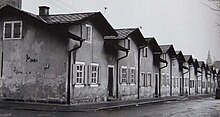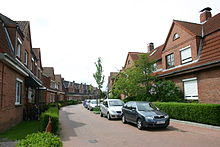Workers settlement
Workers 'settlements , also known at the time as factory settlements , workers' colony or factory colony , were built in the 19th century and in the first half of the 20th century on the initiative of non-profit organizations or entrepreneurs in order to create inexpensive living space for the lower strata of the population. Not to be confused with working-class neighborhoods, which are parts of the city where predominantly working-class families live or have lived.
history
They arose in connection with the housing shortage caused by the migration mainly of the rural population to the industrial centers. The non-profit societies were mostly construction companies in the legal form of stock corporations , construction cooperatives or associations. They mostly acted out of altruistic motives and wanted to improve living conditions for broad sections of the population. Manufacturers acted from a rather selfish drive. They wanted to use the means of building company housing, especially in the rapidly expanding branches of industry, to reduce the fluctuation of workers recruited from the surrounding rural areas and to tie permanent staff of skilled workers and masters to their factories. In addition, they received a not inconsiderable influence on the living habits of their workforce by means of a work apartment as a rental, purchase or premium property. The reading, music and chanting associations founded to develop the taste of the workers, the health insurance companies , savings banks and fire brigades associated with the settlements created security, but also made the residents of these quarters largely materially and mentally dependent.
Architects and construction technology began to deal with the construction of workers' settlements around the middle of the 19th century. The aim of their considerations was not only the efficient production of inexpensive living space, durability and security, but also the size of the houses, appropriate room layout, consideration of light, air and vegetation, but also the leisure and sports opportunities as the basis of healthy living.
Factory settlements

Workers' settlements were also built as factory settlements by companies in the coal and steel industry for their workers and employees. But in other branches of industry, too, the idea of binding employees to their workplaces by means of company-related housing (e.g. cement industry, wood processing industry) came to fruition. The construction of such company apartments was supported by special state funding programs.
The coal and steel industry, especially in the Ruhr area , experienced rapid growth at the end of the 19th century with corresponding increases in migration from neighboring European countries and from economically weak German regions, which led to bottlenecks in the housing market . For the companies in the development zone of the Ruhr area, the recruitment and settlement of workers was therefore a vital problem that one tried to solve by the establishment of factory settlements. These typical colliery colonies were mostly built close to the factories, and renowned architects were often brought in for the planning .
Historic workers' settlements
- In the Württemberg town of Kuchen , the country's largest cotton spinning and weaving mill built the workers' settlement in Kuchen for its workers from 1857 to 1869 . For the times, it was equipped with exemplary and progressive cultural, leisure, supply and health facilities. Part of the estate was redeveloped for around ten million euros after the bankruptcy of the company Süddeutscheotton Industrie AG Kuchen (ESBI) in 1987.
- In Stuttgart , the Postdörfle was built from 1869 to 1871 as the first workers' settlement in Stuttgart for "lower" post and railway employees. The hillside area was accessed by 7 terraces with three-story residential buildings arranged in rows, reminiscent of apartment blocks. Two buildings housed the communal facilities: the bathhouse, canteen, wash house, day nursery and convenience store. The Postdörfle enriched the housing estate with a new variant through the terracing.
- In Bayreuth , the mechanical cotton spinning mill built the first Bavarian social settlement, called Die Burg , from 1861 . With 52 m² of living space on two floors and a small garden, the houses were generously designed for the conditions at the time. By 1909, more than 180 apartments were built for the spinning mill workers and their families. The district largely spared by the bombing raids was completely demolished by 1980.
- Unionvorstadt was established in Dortmund in 1871 by Union Hüttenwerke , one of the first factory settlements in the English style (see Eisenheim settlement ). It was demolished in 1961.
- In today's municipality of Ilsede in Lower Saxony , the Ilseder Hütte company established the Neuölsburg settlement from 1875 . The settlement was given the status of an independent municipality in what was then the district of Braunschweig . The factory estate retained its local self-government until 1964.
- The worsted yarn quarter was built in Augsburg in 1876 for the workers of the Augsburg worsted yarn spinning mill . 1892 the Proviantbach district , as a workers' settlement for the mechanical cotton spinning and weaving mill in Augsburg (SWA) . Both quarters are located in Augsburg's textile district and have been partially (Kammgarnquartier) or almost completely (Proviantbachquartier).
- The Körtingsdorf settlement for the workers of the Körting company was built in Hanover from 1890 . It bordered on the factory premises in the Badenstedt district . The settlement comprised around 50 semi-detached houses with stables and large gardens (around 800 m² each). There was also a school, shops and an inn.
- In the first three decades of the 20th century, workers' settlements were built in Emden for the employees of the Emden harbor and shipyards . These included the districts of Port Arthur / Transvaal and Friesland . Especially in Friesland, but also in Port Arthur / Transvaal, entire streets have been preserved and give an idea of the living conditions at that time. The houses in Friesland were often provided with (utility) gardens in the backyards, which partially enabled the residents to self-suffice with food by growing fruit and vegetables and by keeping animals.
- From 1872 to 1911, BASF built one of the first and largest workers' settlements in Germany at its headquarters in Ludwigshafen , with a total of 420 workers' and supervisors' apartments.
- In neighboring Limburgerhof the built BASF in 1900 and 1914 two more workers colonies which formed the core cell for later independent municipality.
- In Oelsnitz / Erzgeb. Several factory settlements for miners that are still preserved today were built in the 1920s . Among other things, the Höhlholzsiedlung and the Waldesruhsiedlung .
- In Ginsheim (Gustavsburg district) was a workers' settlement 1896-1906 from the mechanical engineering company MAN (then "Klett & Co.") built the Cramer-Klett-settlement whose name MAN's founder Theodor Freiherr von Cramer-Klett ( 1817–1884) .
Listed workers' settlements
- Proviantbachquartier in Augsburg was built between 1892 and 1909 as a workers' settlement for the mechanical cotton spinning and weaving mill in Augsburg and has been under ensemble protection since 1986.
- Freie Scholle in Berlin-Waidmannslust , built in 1895 by Gustav Lilienthal .
- Müsersiedlung , Dortmund-Derne

- Old colony Eving in Dortmund , built between 1898 and 1899 by the United Stein and Hardenberg colliery .
- Altenhof I and II in Essen-Rüttenscheid , built between 1893 and 1914 as a workers' settlement for the Krupp company
- Colony in Frankfurt am Main , built around 1900 as a workers' settlement of Hoechst AG .
- Settlement Flöz Dickebank , Gelsenkirchen-Ückendorf
- "Cramer-Klett-Siedlung" workers' settlement in Ginsheim-Gustavsburg

- Döhrener Jammer in Hanover-Döhren , created between 1869 and the mid-1920s
- In Hessisch Lichtenau in the Werra-Meißner district in North Hesse, a settlement for workers from the heavy weaving mill Fröhlich and Wolff was built from 1907 . All apartments were equipped with running water and stove heating and had their own entrance, a stable and garden land. This was extremely important for the workers recruited from rural areas of Eastern Europe to integrate them into an urban housing situation. By the end of the 1930s, around 120 apartments had been built in around 30 buildings. Today the buildings as a whole are listed as a historical monument . A comprehensive ecological renovation was started in 1995, a block-type thermal power station with a local heating network was built, to which all remaining residential buildings were connected. Extensive renovation work was carried out from 2005. On October 1, 2005, the settlement was transformed into a non-profit GmbH.
- Historical workers' settlement of Kuchen
- Victoria settlement in Lünen-Nord - miners settlement
- Settlement Ziethenstraße (Lunen) - Miners settlement
- Langenstück factory estate in Nachrodt-Wiblingwerde , built between 1904 and 1913
- Eisenheim settlement in Oberhausen , built by Gutehoffnungshütte since 1846 .
- Settlement of the United Strohstoff-Fabriken Coswig in Radebeul-Naundorf
- Garden town Marga in Brieske (district of Senftenberg ), built between 1907 and 1915 as a workers' colony of Ilse Bergbau AG
- The publisher Meyer built the Meyer houses in Leipzig at the turn of the 20th century
literature
in alphabetical order by authors / editors
- German Werkbund Sachsen. Work report 4, Passage-Verlag, Leipzig 2016, ISBN 978-395415-060-1 , (including: Bernd Sikora: Das Lugau-Oelsnitzer Steinkohlenrevier.)
- Frank Dittmeyer: The “Neu Oberhausen” factory estate. A misunderstood architectural gem. In: Shift change. The journal for the history of Oberhausen. Vol. 1, Issue 2, 2006, ZDB -ID 2260526-5 , pp. 6-7.
- Wolfgang Kil , Gerhard Zwickert: Werksiedlungen . Housing form of the industrial age (= time machine Lausitz ). Verlag der Kunst, Dresden 2003, ISBN 3-364-00447-1 .
- Gisbert Knopp: Housing and workers' settlements in the Rhineland. An interim balance from a monument preservation point of view = workbooks of the Rhenish preservation of monuments 67. Wernersche Verlagsgesellschaft , Worms 2006. ISBN 978-3-88462-227-8
- Andreas Koerner, Klaus Scholz, Wolfgang Sykorra : “You were never a stranger.” The Essen mining colony Schönebeck and its district. Edition Rainruhr, Essen 2009, ISBN 978-3-9811598-9-9 .
- Ferdinand Werner : workers' settlements. Workers' houses in the Rhine-Neckar area = contributions to Mannheim's architectural and building history 8. With contributions by Gerold Bönnen and Ulrich Nieß . Wernersche Verlagsgesellschaft , Worms 2012. ISBN 978-3-88462-330-5 .
Web links
- http://www.kuchen.de/arbeitersiedlung.html
- http://www.lausitzer-bergbau.de/historisch/Arbeiterwohnen1.htm
- Westphalia regional: workers' settlements in the Ruhr area
- The black colony in Troisdorf Friedrich-Wilhelms-Hütte
- The BASF workers' settlement in Ludwigshafen-Hemshof
- ARD documentation on the BASF workers' settlement (length 7min)
- Interest group and support association Cramer-Klett-Siedlung Gustavsburg eV


